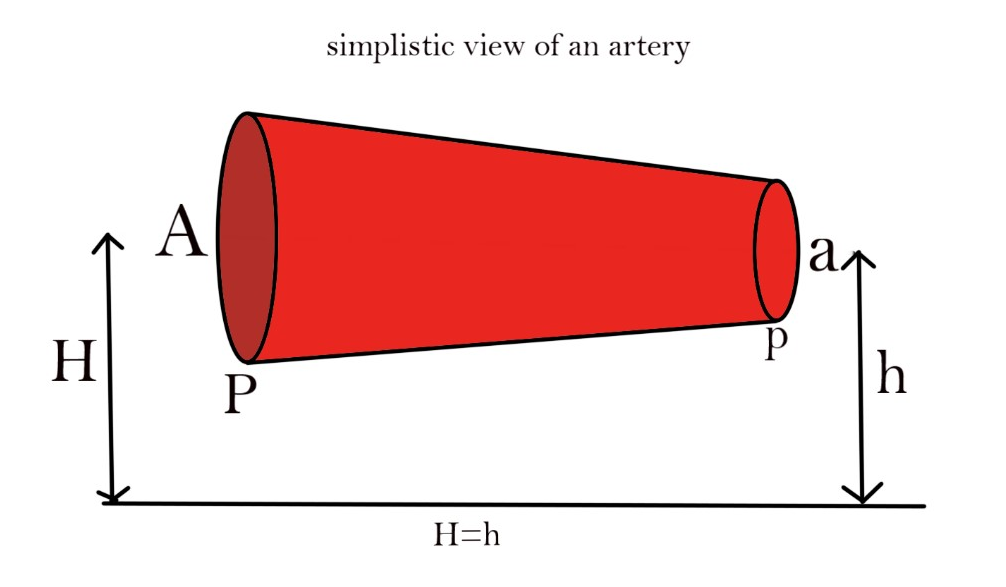
The flow of blood in a larger artery of an anesthetized dog is diverted through a venturi meter. The wider part of the meter has a cross-sectional area equal to that of the artery $A = 8m{m^2}$. The narrower part has area $a = 4m{m^2}$. The pressure drop in the artery is $24Pa$. What is the speed of the blood in the artery? Density of blood is $1.6 \times {10^3}kg/{m^3}$
A)$13.5 \times {10^{ - 2}}m/s$
B) $12.5 \times {10^{ - 2}}m/s$
C) $26.5 \times {10^{ - 2}}m/s$
D) $32.5 \times {10^{ - 2}}m/s$
Answer
510.1k+ views
Hint: The working of the venturi meter is based on the principle of Bernoulli’s equation. Use the equation of continuity of fluid in order to find the relation between the velocities of blood at the two parts of the artery. Then use Bernoulli’s equation to find the velocity.
Bernoulli’s equation is given by the formula,
$P + \rho gH + \dfrac{1}{2}\rho {V^2} = p + \rho gh + \dfrac{1}{2}\rho {v^2}$
Complete step by step solution:

The area at the first part of artery is $A$and at the second part of the artery is $a$
Let the velocity of blood at the first part be $V$and at the second part be $v$
Law of continuity states that the volume of fluid entering in the pipe is equal to the volume of fluid leaving the pipe.
So,
By equation of continuity,
$AV = av$
$8 \times V = 4 \times v$
$2V = v$
Let it be equation 1.
Now,
Bernoulli’s equations states that,
$P + \rho gH + \dfrac{1}{2}\rho {V^2} = p + \rho gh + \dfrac{1}{2}\rho {v^2}$
Where,
P is the pressure of fluid at part 1
P is the pressure of fluid at part 2
H is the height of the pipe at part 1
h is the height of pipe at part 2
but,
there is nothing given about the height of the artery so we assume $H = h$
the equation becomes
$P - p = \dfrac{1}{2}\rho ({V^2} - {v^2})$
$P - p$ is the difference in the pressure and is equal to $24Pa$ according to the question.
$\rho $is the density of blood
$24 = \dfrac{1}{2} \times 1.06 \times {10^3} \times (4{v^2} - {v^2})$
$v = 12.5 \times {10^{ - 2}}m/s$
$\therefore $ The speed of the blood in the artery is $12.5 \times {10^{ - 2}}m/s$. So, option (B) is correct.
Note:
The flow of blood in the arteries is laminar flow. This is the reason we are able to use Bernoulli’s equation for this problem. This equation is only valid in the case of laminar flow.
Bernoulli’s equation is given by the formula,
$P + \rho gH + \dfrac{1}{2}\rho {V^2} = p + \rho gh + \dfrac{1}{2}\rho {v^2}$
Complete step by step solution:

The area at the first part of artery is $A$and at the second part of the artery is $a$
Let the velocity of blood at the first part be $V$and at the second part be $v$
Law of continuity states that the volume of fluid entering in the pipe is equal to the volume of fluid leaving the pipe.
So,
By equation of continuity,
$AV = av$
$8 \times V = 4 \times v$
$2V = v$
Let it be equation 1.
Now,
Bernoulli’s equations states that,
$P + \rho gH + \dfrac{1}{2}\rho {V^2} = p + \rho gh + \dfrac{1}{2}\rho {v^2}$
Where,
P is the pressure of fluid at part 1
P is the pressure of fluid at part 2
H is the height of the pipe at part 1
h is the height of pipe at part 2
but,
there is nothing given about the height of the artery so we assume $H = h$
the equation becomes
$P - p = \dfrac{1}{2}\rho ({V^2} - {v^2})$
$P - p$ is the difference in the pressure and is equal to $24Pa$ according to the question.
$\rho $is the density of blood
$24 = \dfrac{1}{2} \times 1.06 \times {10^3} \times (4{v^2} - {v^2})$
$v = 12.5 \times {10^{ - 2}}m/s$
$\therefore $ The speed of the blood in the artery is $12.5 \times {10^{ - 2}}m/s$. So, option (B) is correct.
Note:
The flow of blood in the arteries is laminar flow. This is the reason we are able to use Bernoulli’s equation for this problem. This equation is only valid in the case of laminar flow.
Recently Updated Pages
Why are manures considered better than fertilizers class 11 biology CBSE

Find the coordinates of the midpoint of the line segment class 11 maths CBSE

Distinguish between static friction limiting friction class 11 physics CBSE

The Chairman of the constituent Assembly was A Jawaharlal class 11 social science CBSE

The first National Commission on Labour NCL submitted class 11 social science CBSE

Number of all subshell of n + l 7 is A 4 B 5 C 6 D class 11 chemistry CBSE

Trending doubts
What is meant by exothermic and endothermic reactions class 11 chemistry CBSE

10 examples of friction in our daily life

One Metric ton is equal to kg A 10000 B 1000 C 100 class 11 physics CBSE

1 Quintal is equal to a 110 kg b 10 kg c 100kg d 1000 class 11 physics CBSE

Difference Between Prokaryotic Cells and Eukaryotic Cells

What are Quantum numbers Explain the quantum number class 11 chemistry CBSE




